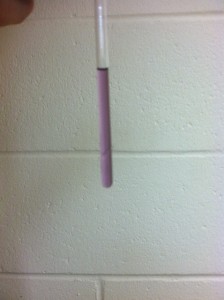Quantitative 13C NMR requires full relaxation of all carbons at each scan, which is typically very long (could mean that you have to set d1 to > 100 seconds). Adding paramagnetic chemicals could speed up the relaxation. A common choice is chromium acetylacetonate, or Cr(acac)3. The trick is to add a suitable amount to your solution. Too little, the 13C T1 will not be short enough. Too much, the signal will be broadened too much (because T2 is shortened too much) and you will lose resolution, and you will experience hardship locking and topshim. Between 0.4wt% and 0.6wt% (3 – 4 mg per 0.5 ml of solvent) is typically used. The solution will have a purple color.
Following is a picture of a standard sample with 0.5wt% Cr(acac)3 for your reference. Add Cr(acac)3 so that your sample has a similar color to this.

If your aim is to obtain a quantitative spectrum so you can integrate all peaks with confidence, you should read in parameter set CARBON1. If your aim is to obtain maximum signal strength, you should read in a different parameter set – C13CPD90 (or C13QUANT), which will result in ca. twice as much signal strength as the default CARBON1.
You will notice that the lock line gets quite noisy – this is normal; when chromium speeds up the T1 relaxation, it also speeds up the T2 relaxation, resulting in broader signals. The same effect is also applied to the solvent, resulting in noisier lock signal. If you have trouble doing Topshim, it is likely due to the noisy lock signal. Try manual shimming.
The same applies to 29Si (and especially so since 29Si T1 is even longer than 13C T1) but you should choose SI29IG, which is run without NOE since NOE of 29Si does not enhance signal. You could also choose SI29QUANT. Note: for best results, you will need to add more Cr(acac)3 than 13C experiments. I recommend 8 mg per tube of 0.5 ml solvent.
